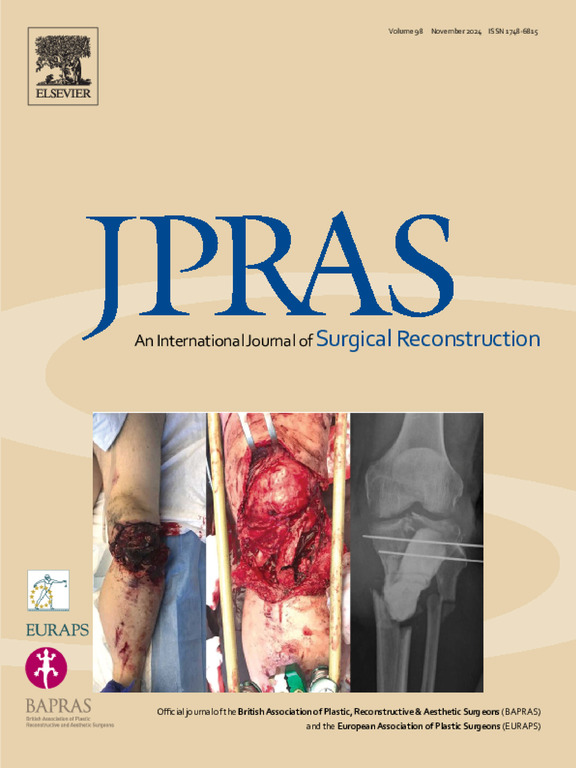可穿戴人体工学设备在整形外科中的未来:系统综述。
IF 2
3区 医学
Q2 SURGERY
Journal of Plastic Reconstructive and Aesthetic Surgery
Pub Date : 2025-03-06
DOI:10.1016/j.bjps.2025.03.007
引用次数: 0
摘要
背景:在过去的十年中,各科外科医生越来越多地使用可穿戴支持设备来减少手术过程中的职业不适。然而,整形外科使用这些设备的情况仍然很少。本综述评估了外科各专科使用的人体工学设备类型及其对减轻疼痛的影响:2024 年 10 月 23 日,我们使用 Embase、PubMed、Scopus、Web of Science 和 Cumulative Index to Nursing and Allied Health Literature 进行了系统检索。纳入标准要求外科医生在同行评议的原创研究中使用可穿戴人体工学设备。两名研究人员独立完成了筛选、提取和结果汇总工作:在确定的 954 篇报告中,有 11 篇文章被选中进行分析。研究的平均样本量为 13 个,外科医生人数从 3 到 25 不等。报告的平均时间为 108 分钟,范围从 10 分钟到 383.5 分钟不等。物理支持设备包括 6 个上肢/身体外骨骼、2 个姿势传感和/或训练设备、1 个下肢/身体外骨骼、1 个颈部外骨骼、1 个躯干外骨骼、1 个基于外骨骼的辐射防护围裙和 1 个外科医生外部支持系统。这些研究主要发生在普通外科,只有一项研究发生在整形外科。所有研究都报告了外科医生使用各自设备的良好体验:本综述显示,近一半已确定的设备为上身/上肢支撑设备,主要用于普通外科,外科医生的使用经验良好。这强调了将这些设备的使用范围进一步扩大到整形外科的可能性,并突出了对整形外科医生在手术室使用这些符合人体工程学的工具的经验进行更多研究的必要性。本文章由计算机程序翻译,如有差异,请以英文原文为准。
The future of wearable ergonomic devices in plastic surgery: A systematic review
Background
Throughout the last decade, surgeons across specialties are increasingly using wearable support devices to minimize occupational discomfort during procedures. However, there is still a paucity of their use in plastic surgery. This review evaluates the types of ergonomic devices used across surgical specialties and their impact on pain reduction.
Methods
A systematic search was conducted on October 23, 2024, using Embase, PubMed, Scopus, Web of Science, and Cumulative Index to Nursing and Allied Health Literature. Inclusion criteria required the utilization of a wearable ergonomic device by surgeons in peer-reviewed, original research. Two investigators independently conducted the screening, extraction, and synthesis of results.
Results
Of the 954 reports identified, 11 articles were selected for analysis. The average study sample size was 13, with a range from 3 to 25 surgeons. The average time reported was 108 min, with a range from 10 to 383.5 min. The physical supporting devices included 6 upper extremity/body exoskeletons, 2 posture sensing and/or training devices, 1 lower extremity/body exoskeleton, 1 neck exoskeleton, one trunk exoskeleton, 1 exoskeleton-based radiation protection apron, and 1 external surgeon support system. These studies took place mainly in general surgery, with only one study in plastic surgery. All studies reported a positive surgeon experience using their respective device.
Conclusion
This review reveals that nearly half of the identified devices were upper body/upper extremity supporting devices, mainly used in general surgery with favorable experiences among the surgeons. This underscores the possibility of expanding the utilization of these devices further into plastic surgery and highlights the need for more research into plastic surgeons’ experiences using these ergonomic tools in the operating room.
求助全文
通过发布文献求助,成功后即可免费获取论文全文。
去求助
来源期刊
CiteScore
3.10
自引率
11.10%
发文量
578
审稿时长
3.5 months
期刊介绍:
JPRAS An International Journal of Surgical Reconstruction is one of the world''s leading international journals, covering all the reconstructive and aesthetic aspects of plastic surgery.
The journal presents the latest surgical procedures with audit and outcome studies of new and established techniques in plastic surgery including: cleft lip and palate and other heads and neck surgery, hand surgery, lower limb trauma, burns, skin cancer, breast surgery and aesthetic surgery.

 求助内容:
求助内容: 应助结果提醒方式:
应助结果提醒方式:


